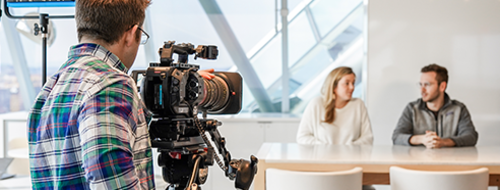How do you feel your best at work?
Before I joined Nestlé, I didn’t know how important it was to feel accepted as my whole self. But my colleagues here have embraced me for everything I am – Tourette's and all.
As a person with Tourette Syndrome, I’m proud to work for a company that continues to make meaningful efforts toward building a culture of Diversity, Equity and Inclusion for all employees – from the top of the company right through to the newest members of the team. That effort was reflected when Disability:IN - the leading nonprofit resource for business disability inclusion worldwide - recognized Nestlé USA, Nestlé R&D and Nestlé Professional with a score of 100 and as a “Best Place to Work for Disability Inclusion” for 2022. This reflects a culture where everyone is made welcome and equipped to perform their best at work.
Here’s just some of the ways we’re working to make Nestlé a great workplace for people with disabilities.
Education and Awareness
Around seven years ago, I started using social media to spread education about Tourette’s syndrome. Growing up, my parents and I didn’t have access to materials that would help us understand what I was going through – to me, social media platforms like Instagram and TikTok have given me the opportunity to share what I’ve learned with others, hopefully making information more accessible for families going through a similar experience to mine.
In the spirit of this education, I joined Nestlé’s THRIVE network, an employee resource group for people with visible and invisible disabilities who are working to educate and raise awareness to build the best possible working environment for employees with disabilities.
The THRIVE network runs educational programs for our colleagues year-long. We recently hosted conversations about invisible and visible disabilities, because you may not always know if the person sitting next to you has a disability that impacts their day. For example, sometimes my tics are visible from the outside, other times I experience exhausting day-long tics in my stomach muscles which are totally invisible to anyone on the outside.
A disability-inclusive workplace starts with empathy. That’s why educational sessions are a major difference maker – the more our people understand about our experiences and differences, the more likely we are to receive the support and understanding needed to do our best work.
A Flexible Workplace
At Nestlé, there are a range of flexible working options tailored to the specific needs of employees. For me, the flexibility to go to the office for collaborative work or choose to work from home on any given day makes a huge difference.
I never know what kind of day I’m going to have, so flexibility as well as open communication and understanding from my manager and team makes it easy for me to manage my day.
Being able to connect with and lean on colleagues who understand my experiences or are working to be great allies is also a huge advantage. It can turn around your day and enable you to do your best work. My colleagues have made me feel comfortable to tic at work, so going into the office and collaborating is sometimes the best way to feel supported.
Every person with a disability is different. There’s no one way to help people with disabilities bring their best selves to work – the important thing is to listen and understand where your colleagues are coming from and how best to help them. I’m so proud that Nestlé has been recognized for the work we’ve done so far, and I’m also excited to see how we continue to build an even better workplace for everyone, no matter what their background or personal experience.
A workplace that embraces individual differences is a better workplace for all.





